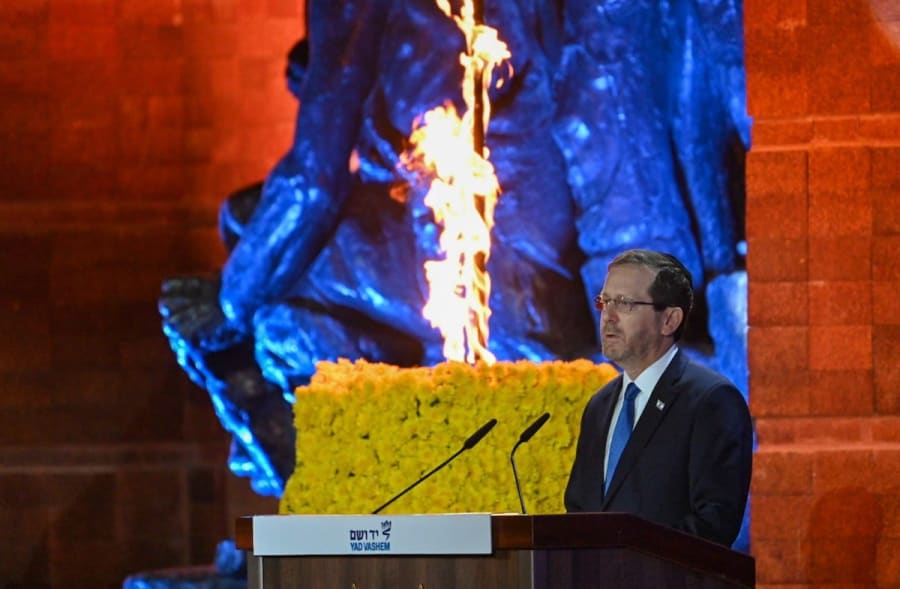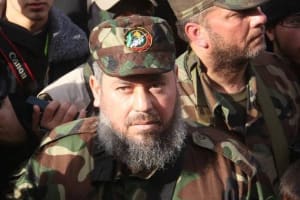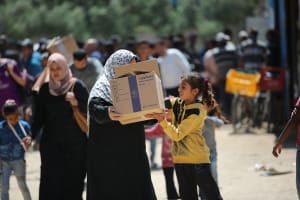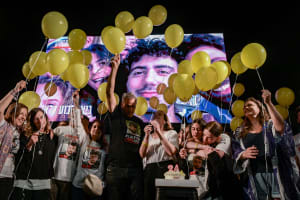[FULL TEXT] Herzog implores country to put disputes aside and 'come together' 'in grief, in remembrance' on Holocaust Remembrance Day
Israeli president shares survivors' stories, 'a museum of skulls and skeletons of an extinct race'

Israeli President Isaac Herzog spoke on Monday night at the state opening ceremony for Holocaust Martyrs’ and Heroes’ Remembrance Day 2023 at Yad Vashem – The World Holocaust Remembrance Center.
Below are Herzog’s full remarks:
At this moment, a moment of majesty, mercy, and truth, we can truly hear the heartbeats of an entire nation, standing before their “Days of Awe”: The week that begins tonight and will end with the conclusion of the State of Israel’s 75th Independence Day. But this year is no ordinary year. And this remembrance day is like no other. This year, feelings are rough and shoulders are hunched, as if to attest to the weight of the discord bearing down on us. I appeal to you, citizens of Israel, with a simple prayer: Let us leave these sacred days, which begin tonight and end on Independence Day, above all dispute; let us all come together, as always, in partnership, in grief, in remembrance.
I wish to speak to you here today about just ten words: a museum of skulls and skeletons of an extinct race. Of the Jewish people. Siegbert Rosenthal was exactly 40 years old when Danny, his eldest son, was born in the summer of 1939, in Berlin, in Nazi Germany. This photograph is a rare image of them together. A small, pure, and simple moment, before their world was destroyed. A father carrying in his arms his son, his only son, the son he loved. A moment before he was bound by the jackboots of the devil, waving their knife and raising their hand against the boy. One can truly see, hear, feel the father’s gentle face. The infant’s laughter. The photograph survived. Its subjects did not. In mid-March 1943, the Rosenthal family—a father, a mother, and a little boy—were deported to Auschwitz. Danny and his mother, Erna, were sent straight to the gas chambers. Danny was only three years and eight months old.
Many stories about the Holocaust end here. This evil alone is enough to terrify anyone “who has breath in his nostrils” (Isaiah 3:22). But in Sigi Rosenthal’s case, the Nazis’ evil knew no bounds. It was not banal; it was infinite. Sigi was sent to forced labor. On his left forearm, the Nazis tattooed the number 107933.
A few months later, he was taken for extermination at the Natzweiler-Struthof camp, on French soil. It would become the opening chapter of a horrifying monstrosity: A museum of skulls and skeletons of an extinct race.
Sigi Rosenthal, little Danny’s father, was one of the 86 human, Jewish victims whose organs were used for experiments by Nazi anthropologists; whose skeletons, noses, ears, cranial structures, and facial features would give voice to “scientific racism” better than any words. Sigi and his fellow Jews were taken, tortured, and murdered in a small and crowded gas chamber, only so that their body parts could be presented in a museum of skulls and skeletons of an extinct race. The museum of horrors that the Nazi beast planned, at the Reichsuniversität Strasburg in France. A collection of limbs belonging to our brothers and sisters, whose bodies were cut open, chopped up and shoved into test tubes and glass bottles to be displayed and catalogued in an orderly fashion.
Time after time after time, the bodies and dignity of the victims of this terrible and dark crime were violated. In the camps, in the gas chambers; even in a medical faculty. “Their blood was shed like water… with none to bury them” (Psalms 79:3).
The museum of skulls and skeletons of an extinct race reflected how, with blood-curdling cruelty, the Nazis were also thinking about the day after. The day when no living Jew would remain anywhere on earth. How would the “enlightened” world, “cleansed” of Jews, recall this extinct inferior race? How would the members of the master race know that it had been right to expunge these Untermenschen from their “pure” human world? This museum was supposed to provide an answer to this question. It was the finale of the Final Solution.
The project had a commander: Professor August Hirt, a doctor, a man sworn to saving lives, who, horrifyingly, made this collection of Jewish organs his life’s work. His people performed measurements of hundreds of inmates in Auschwitz before deciding whose bodies to cut open and chop up and shove into test tubes and glass bottles, for an orderly and cataloged display in a collection, for future visitors.
Eighty-six worlds, worlds of love, joy, and dreams, reduced to dismembered limbs. “And no one knows their burial place to this day” (Deuteronomy 34:6). And they did not find perfect rest. This horrifying, depraved, sick act of murder for the purpose of public display exemplifies the depravity, that “never has such a thing happened or been seen” (Judges 20:30). The depths of the most chilling abyss in human history. Hell itself.
My sisters and brothers, with human courage and divine assistance, the Allies overcame the forces of tyranny. With human courage and divine assistance, spirit triumphed; the spirit of our people, who raised themselves up with scarred wings from the gruesome depths of the Holocaust. It was this spirit that triumphed.
The miracle of our rebirth 75 years ago was the victory of light over darkness. We arose from dust and ashes. The yellow patch gave way to the flag of Israel. The furnaces gave way to the fires of creativity and construction. We founded an exemplary state. As is written: “For the LORD will comfort His people, Will redeem Jerusalem” (Isaiah 52:9).
Survivors of the Holocaust, heroes of the resurrection: With your power, your choice to live, you serve us as a source of inspiration and hope. Every day, including now. It is to you that we look up. To your love of your state and your land. To your love of your people. To your love of man!
The memorial torch, the eternal flame that flickers here at Yad Vashem at the foothills of our nation’s mountain of rebirth, is constrained by neither time nor space. It brings with it eternity; it carries forth meaning. This pillar of fire is the light at the end of the tunnel of the horrors of the Holocaust; it leads us, sustains us, and no less importantly, tasks us with responsibility: a momentous responsibility. Above all, never to be dependent on the mercy of others. To continue sustaining and building our nation and our Jewish and democratic state by ourselves, so that we may grow and prosper as the national home of the Jewish people, and as a beloved, humane, respectful, strong, and stable home for all citizens of Israel.
Another responsibility is the task of memory, and more importantly: The task of learning from memory. We shall remember those who believed in this soul and spirit, who risked their lives to save even a single soul; we will remember, and we will learn from their deeds. We shall remember what Amalek did to us, what the Nazi villains and their accomplices did; we shall remember the horrifying human evil; we shall remember, and we shall fight hatred, anti-Semitism, and racism in all their forms.
Citizens of Israel, this year, all the more so, I wish to add something important here: The Nazi abomination was an unprecedented evil, with no parallel by any metric. It was no mere malice. It was an infinity of horror. We must remember, repeat, and internalize, time and again: they—and they alone—were Nazis. That—and that alone—was the Holocaust. Even in the grips of ferocious disagreements about fate, about destiny, about faith, about values, we must be careful to avoid any comparisons, any equivalences—not with the Holocaust, and not with the Nazis. At the high point of this sacred day, it seems that even the obvious must be stated: For the Nazi monster, opinions within our nation made not the slightest difference. None of the ideologies, beliefs, or ways of life, none of the differences or varieties within our people, bore any meaning.
For them, we were all one people, “scattered and dispersed among the other peoples” (Esther 3:8), whose fate was one: death and extinction. And our victory over them, a victory that unfolds day by day, is of a single nation. We are presently marking 75 years of Israeli rebirth. Seventy-five years of victory, in which the Jewish and democratic State of Israel, and Israeli society, its back straight, stand and declare before the Nazi monster and those who would follow its path, even in this generation: you will not defeat us. For sisters and brothers, we are. Yes, brethren who know how to argue and disagree. But never haters. Never enemies. We are one people, and one people we shall remain, brought together not only by a painful history but also by our shared, hope-filled future and fate.
Dear Holocaust survivors, ladies and gentlemen. I began my speech tonight with the museum of skulls and skeletons, and with this I wish to end, because here too, the eternal people have proven that nothing can extinguish them! Only decades after the end of the war were all the 86 victims given back their names. Warriors of memory and human dignity, absolute saints, from Israel and from the nations of the world, labored for many years for this end, and somehow, through sheer, determined effort, which caused ripples in France and all of Europe—they succeeded. At first, they found numbers. Then, names. Then, the names became people. With life stories. With photographs.
Thus, with a 60-year delay, Hadassah, the daughter of Sarah Bomberg-Birenzweig, discovered what fate befell her mother in the Holocaust. Her mother, Sarah, had placed her in an orphanage in Belgium before she was banished to Auschwitz. When they were separated, she promised her that one day, they would meet again. Sarah was unable to keep her promise. She was taken and murdered, among the victims of the museum of skulls and skeletons of an extinct race.
Her daughter, Hadassah Bomberg, made aliyah to Israel at the end of the Second World War. She got married and settled in the moshav of Nir Galim. She named her eldest daughter after her mother, murdered with the victims of that ghastly museum: Sarah. I spoke this week with Sarah Pastel-Bell, Sarah’s granddaughter, who is here tonight with her family.
This is the most decisive answer to anyone who would call us an extinct race! Sarah and her family are the embodiment of victory and hope. The victory of a nation who once more merited their land, after 2,000 years of exile; a nation who arose from the lowest, most terrible rungs of hell, toward rebirth as a state; a nation blessed with momentous powers of creativity, working in pursuit of tikkun olam, healing a fractured world, as part of the family of nations. A nation who, as long as it still breathes, will continue marching forth and proclaiming: Hineni! We are here! Here! Still, we live! Am Yisrael Chai! The People of Israel live! May the memories of our brother and sisters, victims of the terrible Holocaust, be preserved and bound in our nation’s heart, from generation to generation, forevermore.

The All Israel News Staff is a team of journalists in Israel.













